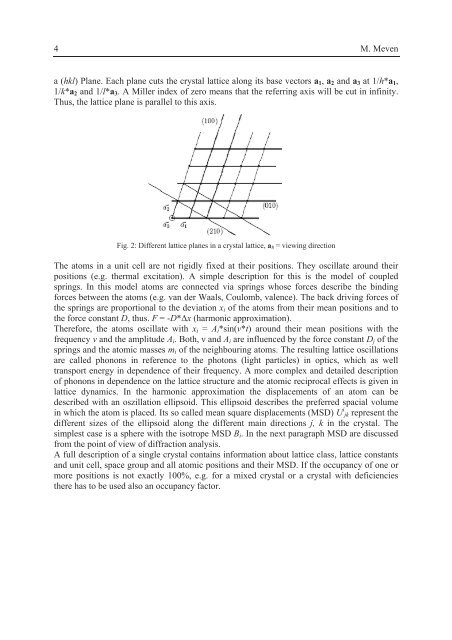Neutron Scattering - JUWEL - Forschungszentrum Jülich
Neutron Scattering - JUWEL - Forschungszentrum Jülich
Neutron Scattering - JUWEL - Forschungszentrum Jülich
Create successful ePaper yourself
Turn your PDF publications into a flip-book with our unique Google optimized e-Paper software.
4 M. Meven<br />
a (hkl) Plane. Each plane cuts the crystal lattice along its base vectors a1, a2 and a3 at 1/h*a1,<br />
1/k*a2 and 1/l*a3. A Miller index of zero means that the referring axis will be cut in infinity.<br />
Thus, the lattice plane is parallel to this axis.<br />
Fig. 2: Different lattice planes in a crystal lattice, a3 = viewing direction<br />
The atoms in a unit cell are not rigidly fixed at their positions. They oscillate around their<br />
positions (e.g. thermal excitation). A simple description for this is the model of coupled<br />
springs. In this model atoms are connected via springs whose forces describe the binding<br />
forces between the atoms (e.g. van der Waals, Coulomb, valence). The back driving forces of<br />
the springs are proportional to the deviation xi of the atoms from their mean positions and to<br />
the force constant D, thus. F = -D*�x (harmonic approximation).<br />
Therefore, the atoms oscillate with xi = Ai*sin(�*t) around their mean positions with the<br />
frequency � and the amplitude Ai. Both, � and Ai are influenced by the force constant Dj of the<br />
springs and the atomic masses mi of the neighbouring atoms. The resulting lattice oscillations<br />
are called phonons in reference to the photons (light particles) in optics, which as well<br />
transport energy in dependence of their frequency. A more complex and detailed description<br />
of phonons in dependence on the lattice structure and the atomic reciprocal effects is given in<br />
lattice dynamics. In the harmonic approximation the displacements of an atom can be<br />
described with an oszillation ellipsoid. This ellipsoid describes the preferred spacial volume<br />
in which the atom is placed. Its so called mean square displacements (MSD) U i jk represent the<br />
different sizes of the ellipsoid along the different main directions j, k in the crystal. The<br />
simplest case is a sphere with the isotrope MSD Bi. In the next paragraph MSD are discussed<br />
from the point of view of diffraction analysis.<br />
A full description of a single crystal contains information about lattice class, lattice constants<br />
and unit cell, space group and all atomic positions and their MSD. If the occupancy of one or<br />
more positions is not exactly 100%, e.g. for a mixed crystal or a crystal with deficiencies<br />
there has to be used also an occupancy factor.

















